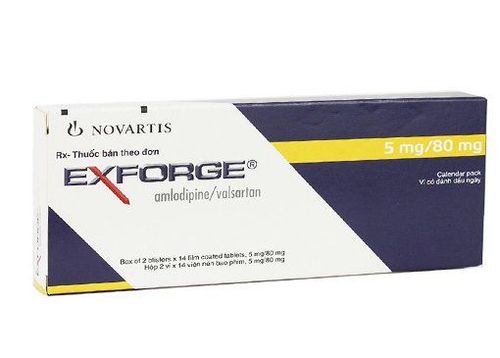Preterax is a medication commonly prescribed for the treatment of essential hypertension (high blood pressure with no identifiable cause). Here is all the information you need to know about Preterax before using it to ensure safety and achieve the best results in treating the condition.
1. What is Preterax?
Preterax is a pharmaceutical product manufactured by Les Laboratoires Servier Industrie, France. It belongs to the cardiovascular and antihypertensive drug group, specifically the Angiotensin-Converting Enzyme (ACE) inhibitors and direct renin inhibitors. The main ingredients are Indapamide (0.625mg) and Perindopril (2mg).
Preterax is formulated as tablets and packaged in a box containing 1 blister pack of 30 tablets.
2. Uses of Preterax
2.1. Effects of Preterax
Preterax is a combination of perindopril tert-butylamine (an ACE inhibitor) and Indapamide (a diuretic from the Chloro sulfamoyl group). The medication has antihypertensive effects and increases urine output.
2.2. Indications for Preterax
Preterax is commonly prescribed for the treatment of essential hypertension (high blood pressure with no identifiable cause).
2.3. Contraindications for Preterax
Preterax is contraindicated in the following cases:
Related to Perindopril:
- Allergy to Perindopril or other ACE inhibitors.
- History of angioedema with previous use of ACE inhibitors or hereditary/idiopathic angioedema.
- Pregnant women over 3 months.
Related to Indapamide:
- Allergy to Indapamide or other sulfonamides.
- Severe renal impairment with creatinine clearance below 30 mL/min.
- Hepatic encephalopathy.
- Severe liver impairment.
- Hypokalemia.
- Breastfeeding.
Related to Preterax:
- History of hypersensitivity to any component of the medication.
- Preterax should not be used in patients undergoing dialysis or those with untreated decompensated heart failure.
3. Side Effects of Preterax
When using Preterax, users may experience the following adverse drug reactions (ADRs):
- Common, ADR > 1/100: Headache, dizziness, fatigue, visual disturbances, tinnitus, hypotension, dry cough, dry mouth, nausea, vomiting, constipation, epigastric pain, abdominal pain, indigestion, diarrhea, loss of appetite, taste disturbances, maculopapular rash, skin rash, itching, muscle cramps.
- Uncommon, 1/1000 < ADR < 1/100: Sleep disturbances, bronchospasm, facial, lip, tongue, limb, laryngeal edema, urticaria, renal impairment, erectile dysfunction, sweating.
Management of ADRs: If any of the above side effects occur, discontinue use and inform a doctor for advice or visit a medical facility for timely management.
4. Drug Interactions
Related to Perindopril and Indapamide:
- Concurrent use of Perindopril and Indapamide with Lithium is not recommended as it can increase Lithium levels and the risk of Lithium toxicity.
- Special caution is needed when used concurrently with Baclofen, which can affect blood pressure-lowering ability.
- Nonsteroidal anti-inflammatory drugs (NSAIDs), including high-dose acetylsalicylic acid, can reduce the antihypertensive effect of Perindopril. Concurrent use of ACE inhibitors and NSAIDs can increase the risk of acute renal failure and impaired renal function, and increase serum potassium levels, especially in patients with pre-existing renal impairment.
- Antidepressants similar to Imipramine (tricyclic antidepressants) and sedatives can enhance the antihypertensive effect.
- Corticosteroids and Tetracosactide can reduce the antihypertensive effect.
- Concurrent use with other antihypertensive drugs can cause excessive hypotension.
Related to Perindopril:
- Concurrent use with potassium-sparing diuretics, potassium supplements, or potassium salts is not recommended as it can reduce the diuretic effect, leading to potassium loss. These medications can significantly increase serum potassium levels (potentially fatal).
- Special caution is needed when used concurrently with diabetes medications (insulin, sulfonylureas) as it can enhance the hypoglycemic effect.
- Caution is required when used concurrently with Allopurinol, cytostatic agents, immunosuppressants, synthetic corticosteroids, or procainamide as it can increase the risk of leukopenia.
- Concurrent use with anesthetics can enhance the hypotensive effect of some anesthetics.
- Thiazide or loop diuretics can lead to reduced blood volume and increase the risk of hypotension.
Related to Indapamide:
- Special caution is needed when used concurrently with medications that have a risk of causing torsades de pointes, such as Class IA antiarrhythmics (Hydroquinidine, Disopyramide, Quinidine); Class III antiarrhythmics (Amiodarone, Bretylium, Dofetilide, Ibutilide, Sotalol); some antipsychotics (Chlorpromazine, Cyamemazine, Thioridazine, Levomepromazine, Trifluoperazine), due to the risk of hypokalemia.
Medications that cause hypokalemia, such as intravenous Amphotericin B, systemic Glucocorticoids and Mineralocorticoids, Tetracosactide, and stimulant laxatives, increase the risk of hypokalemia (side effect). - Cardiac glycosides: Low potassium levels increase the toxicity of cardiac glycosides.
Metformin: Causes lactic acidosis due to its potential impact on renal function related to diuretic effects. - Iodine-containing contrast agents: When diuretics cause dehydration, the risk of acute renal failure increases, especially with high doses of iodine-containing contrast agents.
- Calcium (salts): Increases the risk of hypercalcemia due to reduced calcium excretion through urine.
5. Precautions and Warnings When Using Preterax
When using Preterax, patients need to pay attention to the following issues to ensure safety:
- The medication should only be used when prescribed by a specialized doctor. Follow the doctor's instructions and do not adjust the dosage without medical advice.
- Caution is needed when using Perindopril in patients with collagen vascular disease, those undergoing immunosuppressive therapy, or taking Allopurinol or Procainamide, especially in patients with pre-existing renal impairment, as it may cause neutropenia or agranulocytosis.
- Rare cases of facial, lip, tongue, and limb edema have been reported in patients treated with ACE inhibitors, including Perindopril. If these side effects occur, discontinue Perindopril immediately and establish appropriate control measures to prevent these symptoms.
- Do not use Perindopril in combination with potassium-sparing diuretics or potassium salts.
- Pregnant and breastfeeding women should avoid using the medication to prevent potential effects on pregnancy and infants.
- The individual components of the medication do not affect the ability to drive or operate machinery. However, some patients may experience side effects related to hypotension, so they should avoid driving or operating machinery if these side effects occur.
6. Missed Dose and Overdose of Preterax
- Missed Dose: Take the missed dose as soon as you remember, within 1-2 hours of the scheduled time. If it is close to the time for the next dose, skip the missed dose and continue with the next dose as planned. Do not double the dose to make up for the missed dose to avoid overdose or increased side effects.
- Overdose: If an overdose occurs, quickly eliminate the medication from the body by gastric lavage and/or taking activated charcoal. Then, rehydrate and balance electrolytes at a specialized medical facility until these parameters return to normal.
If significant hypotension occurs, place the patient in a supine position with the head lowered. If necessary, administer intravenous isotonic saline or use measures to increase circulating volume at a medical facility.
7. Storage of Preterax
The medication should be stored in a dry place with a temperature between 15-30°C, away from direct sunlight and moisture. The blister pack should be discarded 2 months after opening the box.
Keep the medication out of reach of children to prevent them from accidentally ingesting it, which could affect their health.
For medications that are no longer in use or have expired, dispose of them safely according to the instructions of a doctor or local waste disposal company. Do not flush the medication down the household sink or toilet.
The information provided about Preterax is for reference only. To use the medication safely, effectively, and at the correct dosage for optimal treatment results, patients should consult a specialized doctor for advice, prescription, and appropriate dosage.
To arrange an appointment, please call HOTLINE or make your reservation directly HERE. You may also download the MyVinmec app to schedule appointments faster and manage your reservations more conveniently.








